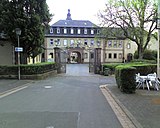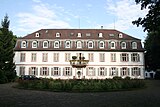County of Isenburg

Isenburg was a region of Germany located in southern present-day Hesse, located in territories north and south of Frankfurt. The states of Isenburg emerged from the Niederlahngau (located in the Rhineland-Palatinate), which partitioned in 1137 into Isenburg-Isenburg and . These countships were partitioned between themselves many times over the next 700 years.
House of Isenburg[]

The House of Isenburg was an old aristocratic family of medieval Germany, named after the castle of Isenburg in Rhineland-Palatinate. Occasionally referred to as the House of Rommersdorf before the 12th century, the house originated in the Hessian comitatus of the Niederlahngau in the 10th century. It partitioned into the lines of Isenburg-Isenburg and Isenburg-Limburg-Covern in 1137, before partitioning again into smaller units, but by 1500 only the lines of Isenburg-Büdingen (in Upper Isenburg) and Lower Isenburg remained. In 1664 the Lower Isenburg branch died out. The Büdingen line continued to partition, and by the beginning of the 19th century the lines of Isenburg-Büdingen, Isenburg-Birstein, Isenburg-Meerholz and Isenburg-Wächtersbach existed. Today still exist the (Roman Catholic) princes of Isenburg (at Birstein), the (Lutheran) princes of Ysenburg (at Büdingen and Ronneburg) and the (Lutheran) counts of Ysenburg-Philippseich.
"Family tree" of the Isenburg countships[]






Isenburg, the original countship was divided in 1137 into:
- Isenburg (or Isenburg-Isenburg), 1137–1199, eventually dividing c. 1210 into:
- Isenburg-Braunsberg, 1210–1388, when it was renamed Isenburg-Wied. Isenburg-Wied, in turn, existed from 1388–1454, when it passed by marriage to the Lords of Runkel and was superseded by the Countship of Wied in 1462.
- Nieder-Isenburg (Lower Isenburg), 1218–1502 when it was divided into:
- Isenburg-Grenzau, 1502–1664. After the death of Count in 1664 without direct heirs, his territories were claimed back as feudal tenures by the Archbishoprics of Cologne and Trier, and the Abbey-principality of Fulda. The core territories including Isenburg were passed on by Fulda to the Counts of Walderdorff. They had to share them according to a later agreement with the Counts of Wied, by then a cadet branch of the Isenburgs.
- Isenburg-Neumagen, 1502–1554, when it passed by marriage to the Counts of Sayn-Homburg.
- Isenburg-Kempenich, 1137–1424, when it passed to the Lords of Schöneck. In 1434, it passed to the Archbishop of Trier, who sold the territory to the Counts of Virneburg.
- , 1137–1158, when it was divided into:
- Isenburg-Covern, 1158–1306, when it passed to Isenburg-Cleberg.
- Isenburg-Grenzau, 1158–1258, when it was divided into:
- Isenburg-Limburg, 1258–1406, when it was annexed by the Archbishopric of Trier
- Isenburg-Grenzau, 1258–1287, when it was divided into:
- Isenburg-Grenzau, 1287–1290, when it passed to Isenburg-Cleberg.
- Isenburg-Arnfels, 1286–1379, when it passed to Isenburg-Wied.
- , 1287–1340, when it was divided into:
- Isenburg-Grenzau, 1340–1439, when it passed to Nassau-Beilstein. It subsequently passed to the Archbishopric of Trier in 1446, and was finally purchased by the Counts of Nieder-Isenburg in 1460.
- Isenburg-Büdingen, 1340–1511, when it was divided into:
- , or Isenburg-Ronneburg, 1511–1601, when it was annexed by Isenburg-Büdingen-Birstein
- Isenburg-Büdingen-Birstein (or Isenburg-Birstein), 1511–1628, which was divided into:
- Isenburg-Birstein, 1628–1664, when it passed to Isenburg-Offenbach
- Isenburg-Büdingen, 1628–1685, when it was divided into:
- Isenburg-Büdingen, 1685–1806, when it was mediatized to the Principality of Isenburg
- Isenburg-Wächtersbach, 1685–1806, when it was mediatized to the Principality of Isenburg
- Isenburg-Meerholz, 1685–1806, when it was mediatized to the Principality of Isenburg
- , 1685–1725
- Isenburg-Offenbach, 1628–1711, when it was divided into:
- Isenburg-Birstein, 1711–1744, when it became the Principality of Isenburg-Birstein. The Principality existed from 1744-1806, when it was renamed the Principality of Isenburg, 1806–1814/5
- Isenburg-Eisenberg, 1711–1758, when it was absorbed back into the Principality of Isenburg-Birstein
- Isenburg-Philippseich, 1711–1806, when it was mediatized to the Principality of Isenburg
Principality of Isenburg[]
It was not until 1806 that there was a state called simply "Isenburg". When the Holy Roman Empire was defeated by Napoleon I of France in that year, the empire was abolished and the Confederation of the Rhine was established amongst the various German states. As an incentive to join the Confederation, it was stated that any state which joined could mediatise their neighbours. Prince Charles of Isenburg-Birstein joined the Confederation and was granted the mediatized Isenburgian Countships of Isenburg-Büdingen, Isenburg-Meerholz, Isenburg-Philippseich, and Isenburg-Wächtersbach. His Principality was renamed to Isenburg.
The Principality continued under the rule of Prince Charles through the Napoleonic era, but was mediatised by Austria in December 1813, at the insistence of King Frederick William III of Prussia, who was angered that Isenburg had raised a regiment for French service by recruiting Prussian deserters and vagabonds.[1] Isenburg was one of only three original member princes of the Empire to be mediatized at the end of the Napoleonic era (the others being Leyen and prince-primate Dalberg, Prince of Aschaffenburg). This decision was confirmed at the Congress of Vienna. The lands of the principality were divided between the Grand Duchy of Hesse-Darmstadt and the Electorate of Hesse-Kassel (or Hesse-Cassel).
Princes of Isenburg (1806–1814/5)[]
- , 1806–1814/5
Mediatized (1815)[citation needed][]
- Charles, 1st Prince 1803-1820 (1766-1820)
- Wolfgang Ernst, 2nd Prince 1820-1866 (1798-1866)
- Prince Victor (1802-1843)
- Karl, 3rd Prince 1866-1899 (1838-1899)
- Prince Leopold (1866-1933) -renounced his rights in 1898
- Franz Joseph, 4th Prince 1899-1939 (1869-1939)
- Franz Ferdinand, 5th Prince 1939-1956 (1901-1956)
- Franz Alexander, 6th Prince 1956–2018(1943-2018)
- Alexander, 7th Prince 2018–present (1969) ∞ Sarah Lorenz
- Princess Alix (2015)
- Princess Zita (2017)
- Franz Salvator, Hereditary Prince (2019)
- Princess Katharina (1971) ∞ Archduke Martin of Austria
- Princess Isabelle (1973) ∞ Carl, Prince of Wied
- Princess Sophie (1978) ∞ Georg Friedrich, Prince of Prussia
- Prince Viktor (1979) ∞ Jungeun Anes Lee
- Princess Amalia (2016)
- Princess Victoria (2018)
- Alexander, 7th Prince 2018–present (1969) ∞ Sarah Lorenz
- Franz Alexander, 6th Prince 1956–2018(1943-2018)
- Franz Ferdinand, 5th Prince 1939-1956 (1901-1956)
- Karl, 3rd Prince 1866-1899 (1838-1899)
Princes of Isenburg and Büdingen[]
Notable members[]
- Imagina of Isenburg-Limburg, c. 1255 – 29 September 1313?, Queen consort of Adolf of Nassau, king of Germany
- Diether von Isenburg, c. 1412 – 1482, Elector and Archbishop of Mainz
- Anna of Isenburg-Büdingen, 1460 – 1522
- John of Isenburg-Grenzau, Archbishop-Elector of Trier from 1547 until 1556
- Salentin IX of Isenburg-Grenzau, c. 1532–1610, Archbishop-Elector of Cologne, Bishop of Paderborn
- Ernst Casimir II, 2nd Prince of Ysenburg and Büdingen, 1806-1861
- Bruno, 3rd Prince of Ysenburg and Büdingen, 1837-1906
- Princess Sophie Johanna Maria of Isenburg (born 1978), wife of Georg Friedrich, Prince of Prussia
References[]
- ^ Treitschke, Heinrich. History of Germany in the Nineteenth Century, Vol. I, page 609.
External links[]
- Official Website – Fürstenhaus Isenburg (Princely House of Isenburg) (in German)
- House of Isenburg
- States of the Confederation of the Rhine
- Counties of the Holy Roman Empire
- Former states and territories of Rhineland-Palatinate
- Upper Rhenish Circle
